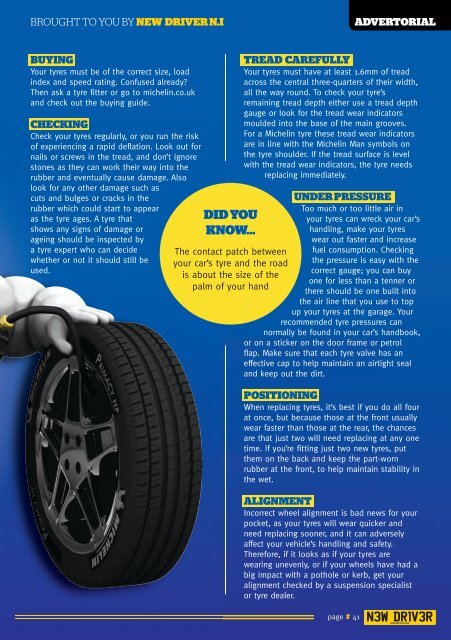Create successful ePaper yourself
Turn your PDF publications into a flip-book with our unique Google optimized e-Paper software.
BROUGHT TO YOU BY NEW DRIVER N.I<br />
ADVERTORIAL<br />
BUYING<br />
Your tyres must be of the correct size, load<br />
index and speed rating. Confused already?<br />
Then ask a tyre fitter or go to michelin.co.uk<br />
and check out the buying guide.<br />
CHECKING<br />
Check your tyres regularly, or you run the risk<br />
of experiencing a rapid deflation. Look out for<br />
nails or screws in the tread, and don’t ignore<br />
stones as they can work their way into the<br />
rubber and eventually cause damage. Also<br />
look for any other damage such as<br />
cuts and bulges or cracks in the<br />
rubber which could start to appear<br />
as the tyre ages. A tyre that<br />
shows any signs of damage or<br />
ageing should be inspected by<br />
a tyre expert who can decide<br />
whether or not it should still be<br />
used.<br />
DID YOU<br />
KNOW...<br />
The contact patch between<br />
your car’s tyre and the road<br />
is about the size of the<br />
palm of your hand<br />
TREAD CAREFULLY<br />
Your tyres must have at least 1.6mm of tread<br />
across the central three-quarters of their width,<br />
all the way round. To check your tyre’s<br />
remaining tread depth either use a tread depth<br />
gauge or look for the tread wear indicators<br />
moulded into the base of the main grooves.<br />
For a Michelin tyre these tread wear indicators<br />
are in line with the Michelin Man symbols on<br />
the tyre shoulder. If the tread surface is level<br />
with the tread wear indicators, the tyre needs<br />
replacing immediately.<br />
UNDER PRESSURE<br />
Too much or too little air in<br />
your tyres can wreck your car’s<br />
handling, make your tyres<br />
wear out faster and increase<br />
fuel consumption. Checking<br />
the pressure is easy with the<br />
correct gauge; you can buy<br />
one for less than a tenner or<br />
there should be one built into<br />
the air line that you use to top<br />
up your tyres at the garage. Your<br />
recommended tyre pressures can<br />
normally be found in your car’s handbook,<br />
or on a sticker on the door frame or petrol<br />
flap. Make sure that each tyre valve has an<br />
effective cap to help maintain an airtight seal<br />
and keep out the dirt.<br />
POSITIONING<br />
When replacing tyres, it’s best if you do all four<br />
at once, but because those at the front usually<br />
wear faster than those at the rear, the chances<br />
are that just two will need replacing at any one<br />
time. If you’re fitting just two new tyres, put<br />
them on the back and keep the part-worn<br />
rubber at the front, to help maintain stability in<br />
the wet.<br />
ALIGNMENT<br />
Incorrect wheel alignment is bad news for your<br />
pocket, as your tyres will wear quicker and<br />
need replacing sooner, and it can adversely<br />
affect your vehicle’s handling and safety.<br />
Therefore, if it looks as if your tyres are<br />
wearing unevenly, or if your wheels have had a<br />
big impact with a pothole or kerb, get your<br />
alignment checked by a suspension specialist<br />
or tyre dealer.<br />
page # 41


